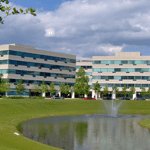Commercial real estate firms are in a position to have an enduring influence on sustainable building operations. After all, they have the opportunity to implement and monitor the building’s various systems and plan for eco-friendly upgrades as part of renovation efforts. And preparations made in design and construction phases are ineffective if those systems aren’t achieving the desired results when they’re operational.
Matthew Payne, a property manager with Transwestern, a global provider of commercial real estate services, knows this well. Working in a company that has more than 56 LEED-certified properties in the country, Payne knows that sustainability doesn’t stop with certification.
Transwestern has been at the forefront of sustainability initiatives for more than a decade. “Our initial partnership with Energy Star began in the late 1990s,” says Al Skodowski, who is Transwestern’s senior vice president and director of LEED and sustainability services and chairman-elect for the USGBC. “As a result of California’s energy crisis, our energy program has been solidified, and we have a top-down commitment to managing the most energy-efficient properties in the country.”
Because Transwestern is a global company, its wide reach has brought new opportunities in its commitment to reducing the environmental impact of its properties. Pilot programs at a single location can be expanded for significant savings of cost and resources throughout the country. For example, the firm has developed a night audit program in which every property has after-hours walk-throughs to identify unnecessary energy use when electronic devices aren’t turned off or in energy-saving mode.
Clients play a major role in Transwestern’s commitment to sustainability and often drive the process, as was the case with TIAA-CREF, a financial services firm and its Capital Gateway building that earned LEED Platinum under the Existing Buildings: Operations and Maintenance rating system. Owners such as TIAA-CREF and its tenants get major benefits from a sustainable commitment. Even with a full-service lease, operating expenses influence the rate, and lower operating expenses equal lower rent. Nonetheless, some clients are hesitant at the initial investment that some features require to eventually reduce resource consumption. “Inexpensive retrofits provide some energy savings,” Skodowski says, “but a building can be made so much more efficient for a small premium.” Payne adds that if you want to go Platinum, you have to make an investment. “You’ll get a huge payback from that, though.”
Collaboration with entities ranging from local vendors to national associations is also essential, Payne says. “You have to make sure that the building staff, contractors, and vendors are all doing what they need to be doing.” he says. “This is an enormous team effort.” Transwestern partners with groups like the Building Owners and Managers Association (BOMA) and Real Estate Roundtable, even with competing firms.
At the same time, Transwestern has developed its own initiatives to be more sustainable, such as the Good, Better, Best Program, which is designed to incorporate sustainability into all of the organization’s functions. The program takes into account that its properties have different sustainable goals in mind; some want to at least start a recycling program while others are seeking LEED certification, so the Transwestern system identifies how a facility is operating now, the level of its managers’ knowledge about sustainability, and how the facility can improve.
Although Transwestern has established itself as a leader in sustainability, opportunities for additional progress remain. Even with Platinum certifications, Payne says there are still credits to go after and ways to improve every day.

